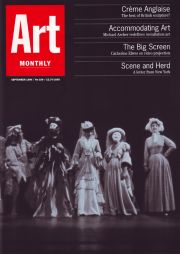Feature
Créme Anglaise
Patricia Bickers samples ‘Un siècle de sculpture anglaise’ at the Jeu de Paume
At a time when several major French institutions, including the Pompidou Centre and the Jeu de Paume,* have been given over to the celebration of British sculpture, it may seem churlish, ungrateful even, to question some of the assumptions underlying this generous gesture – the more so since as one disgruntled commentator, reviewing ‘Un siècle de sculpture anglaise’ at the Jeu de Paume, justifiably observed, FrancoBritish cross-Channel cultural exchanges have tended to be somewhat one-sided of late.1
Apart from ‘quelques old chaps’ like Cézanne, he complained, French artists are never shown in London which just goes to show that, while the English may be ‘kings’ in the realm of sculpture, their true talent lies in their ability, with the help of the British Council, to export their art while remaining impervious to that of the rest of Europe.
However, while the review attacks British insularity and is critical of the exhibition itself, neither it nor any of the other critical responses in French newspapers and magazines that I have read question the assumption that Britain’s ‘native genius’ in the visual arts manifests itself primarily in sculpture (Turner and Bacon, the latter the subject of a retrospective at the Pompidou Centre, being notable exceptions to this rule). This is, of course, the basic premise which informs the exhibition, curated by Daniel Abadie, Director of the Jeu de Paume. It also informed the British Council/MUHKA (Museum van Hedendaagse Kunst)-sponsored exhibition, ‘British Sculpture 1960-1988’, which could be said to have set the parameters for the present exhibition. The curator of the earlier show, Catherine Grenier, like Abadie later, identified Henry Moore as ‘the epitome of a particular type of British artist’ and, also like Abadie, saw the arrival of Jacob Epstein and the response of Moore and Barbara Hepworth to his work, as the defining moment of modern British sculpture: ‘From then on, sculpture was at the forefront, the prime mover of the emerging [British] artistic identity’. Abadie, however, goes much further, claiming in his catalogue essay that, ‘while other countries have produced certain figures who are essential to the history of this art [of sculpture], from Brancusi to Arp, from Calder to Tinguely, no one can claim, like Britain, to have contributed, to each generation, artists such as Epstein, Moore or Caro’. To quibble with such a ringing endorsement may seem not merely churlish and ungrateful but downright perverse. Nevertheless, it is worth looking more closely at all this emphasis on sculpture, particularly as it comes at a time when art from Britain is grabbing so much attention abroad.
‘Art’ that is, not sculpture alone, and ‘from Britain’ rather than ‘British’ or, for that matter, ‘English’. The conflation of English with British throughout Abadie’s essay and in the French press coverage is part of the problem, exascerbated by the British Council’s press release which actually translates the title of the exhibition as, ‘A Century of British Sculpture’. It may be that in French usage the two have been hitherto interchangeable but this situation can no longer be tolerated – particularly in an exhibition which, while emphasising the variety and inventiveness of sculpture in Britain, nevertheless defines it in terms of somewhat cliched notions of national characteristics such as the relationship of art in Britain with landscape, underlined by the controversial extension of the exhibition into the surrounding Tuileries gardens, and the oft-cited reliance on humour and a certain whackiness. It cannot be, surely, that the conceptual piece Oak Tree by Irish-born artist, Michael Craig-Mairtin, which reportedly arouses much laughter, was included because its title relates it in some way to that landscape tradition?
Of course not. Yet this is precisely the kind of oversimplified conclusion encouraged by this telescoped view of ‘English sculpture’. Many critics, both in Britain and in France, have commented on the unsuitability of the elegantly remodelled Jeu de Paume gallery as a venue for such an ambitious show purporting to cover a century – actually 80 years – of English sculpture beginning with Epstein’s Rock Drill of 1913 and ending with Damien Hirst’s Mother and Child Divided of 1993. However, in the course of an interview in Connaissance des Arts, Abadie declined to plead that lack of space in part dictated his choice of work; on the contrary, he pointed out that the emphasis on the 70s, for instance, was a deliberate bias, ‘un parti pris’, reflecting his own preference: ‘If you look carefully, you will see that three rooms are devoted to works from 1913 to 1970, and five rooms to those of 1970 to today […] I have chosen – it is a bias that is fundamental to the exhibition – not to show all the developments in English sculpture, but to place the accent on some personalities’. Furthermore, when he was asked whether this had resulted in the decision to put on a show that represented ‘un “best-of”’ – a compilation of the cream of English sculpture – Abadie agreed that it did, but rejected the criticism implicit in the choice of the term ‘best-of’ which, he pointed out, is generally used perjoratively, especially in reference to musical compilations. Instead, he chose to address the question literally, adding that at times he had taken his pursuit of the ‘best’ to extremes, citing the example of the lengths he went to to secure a green-patinated version of Moore’s bronze King and Queen, which apparently endows the sculpture with special qualities that are not present in the brown-patinated versions more commonly available. Unfortunately, it seems that his desire to include Hirst’s The Physical Impossibility of Death in the Mind of Someone Living, otherwise known as the ‘shark piece’, was thwarted by the fact that it was too large.
What all this makes plain is that this exhibition is not a history of ‘English sculpture’ at all; it is a personal selection, a visual essay. No one would have quarrelled with this had it been made clear from the outset. Freed from the constraints of historical rigour many of us would prefer to take a huge chronological leap, like one of Barry Flanagan’s rampant hares, from the 30s to the exciting 60s, bypassing altogether the tedious rhetoric of the post-war Geometry of Fear sculpture – even though it helps to make sense of later sculptural developments. (These and 60 other notable exclusions, among them William Turnbull and William Tucker, are included in a supplementary Dictionnaire in the catalogue.) Seen in this light, the show offers a French audience an opportunity to sample – a more appropriate musical analogy I would suggest – a wide range of work made in Britain over the last 80 years that is thoughtfully, occasionally provocatively, displayed, in the most beautiful venue in Paris.
However, if the viewer troubles to read the catalogue, it becomes clear that the selection is actually intended to illustrate the Director’s particular, not to say peculiar, thesis signalled in the title of his sub-Freudian essay: ‘Assassination Considered as a Fine Art’. Deriving his argument from an essay about the origins of the novel by Marthe Robert, Abadie argues that English sculpture is a family affair, an endless Oedipal cycle in which each generation succeeds the next through the ‘ritual murder of the father’, of the teacher by the student, proving that the rejection of tradition is itself a tradition, one which provides the ‘dialectical motor’ in, to mix metaphors, ‘the evolution of English sculpture’. In fact, this is only a reworking, in somewhat lurid terms, of the received view, again prefigured in Catherine Grenier’s 1988 essay, and also discussed earlier by Charles Harrison in ‘Sculpture’s Recent Past’, his contribution to A Quiet Revolution: British Sculpture Since 1965,2 published in 1987. Such a dramatic thesis is bound to exclude a number of artists who don’t fit this scenario, indeed, they must be excluded in order to preserve the thesis.
However, none of this explains the inclusion of Hirst’s Mother and Child Divided. The fact that a work is three-dimensional does not automatically guarantee its status as sculpture. For a work to be understood as sculpture it must not only result from an engagement with the language and tradition of sculpture – even if it ultimately repudiates it – but the artist’s intention must also be taken into account. Unlike the work of Antony Gormley and Rachel Whiteread or even of Jeff Koons, whose influence Hirst himself has acknowledged, Hirst’s work cannot be defined by, or indeed confined within, a sculptural tradition; like so many of his contemporaries, Hirst works across all disciplines, in various media and in two and three dimensions, so that when a work is presented in the form of an object, it is less to do with its status as sculpture than with the nature of the experience that the artist wishes to engender in the viewer. It therefore makes no sense to include his work in this exhibition.
On the other hand, the decision to include Hirst is perhaps explicable, given Abadie’s disatisfaction, discussed in the interview cited earlier, with the view of contemporary art that emerged in the 80s when the term itself, ‘contemporary art’, became in his view a kind of ‘catch-all’ label that covered everything that we either did not understand or which appeared to be new. While it is true that the distinction in art between contemporary and, for example, modern, is difficult to define other than in the crudest chronological sense, the designation ‘contemporary art’ at least gives us pause; it suggests that the art in question cannot immediately or easily be assimilated with past practices. What gives this exhibition such a ‘dated’ feel is this attempt to subsume Hirst into a British sculpture tradition; the story goes something like this: the ‘British genius’ in art is for sculpture; Hirst is a major British artist; ergo, he must be a sculptor.
*Tony Cragg, ‘Retrospective’, Centre Pmpoidou, Spring 1966; Henry Moore, ‘L’expression première’, Musée des Beaux-Arts, Nantes until September 2; ‘Un siécle de sculpture anglaise’, Galerie nationale du Jeu de Paume, Paris, until September 15; Anthony Caro was at the Galerie Lelong, Paris until July 30 and Barry Flanagan was at the Durant-Dessert Gallery until July 27.
1. Denis Angus, ‘Histoire d’un flop’, Technikart, July, 1996, p.29.
2. See also, Patricia Bickers, ‘Generations of British sculputre: the British Sculpture Tradition’, Artpress, No.202, May 1995, pp.31-39.
Patricia Bickers is editor of Art Monthly.
First published in Art Monthly 199: September 1996.









